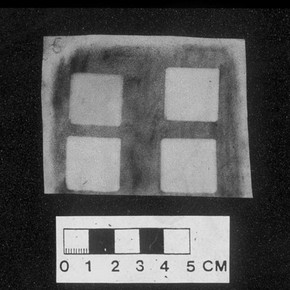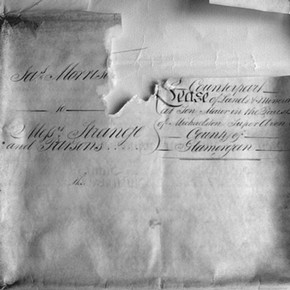Conservation Journal
Spring 2002 Issue 40
Critical evaluation of laser cleaning of parchment documents
Since October 2001 I have been a part-time PhD student on the RCA/V&A Conservation programme, combining research with my job as Lecturer at the School of Conservation, Copenhagen. The title of the project is 'A Critical Evaluation of Laser Cleaning of Parchment Documents with a Short-Pulsed Q-switched Nd:YAG Laser at 1064, 532 and 266 nm'. This paper deals with the overall considerations made before making the project proposal which focuses on rather traditional conservation research into a new cleaning method, proposed in the age of preventive conservation.
The use of lasers for cleaning works of art and other cultural objects is a topic of great interest today. The method has become an established tool in sculpture conservation workshops throughout Europe. In particular, the Nd:YAG laser has proved its potential for cleaning sculptures made of inorganic materials such as marble, limestone and sandstone. The principle of laser cleaning is based on the difference in absorption of laser radiation in dirt and in the substrate. This difference should be large enough to ensure that dirt absorbs radiation and is ablated while the underlying substrate reflects the incident radiation after removal of dirt. This enables a non-contact, self-limiting cleaning process. These ideal circumstances for laser cleaning have not been as obvious for organic materials as for some inorganic materials and therefore the adoption of laser technologies for cleaning organic materials was much slower. Research into this area is now increasing, in part because of the perceived undesirable side effects associated with traditional cleaning methods that inevitably involve some form of contact with the object.

Figure 1. Laser cleaning experiments on new parchment covered with artificial dust, performed at four fluence levels at 532 nm. Photography by Martin Cooper (click image for larger version)
Parchment documents are an important part of our cultural heritage, being the bearers of historic information that throws light on the roots of our modern society. It is therefore natural that their conservation, including cleaning, is subject to discussion not only between conservators but also with curators, archivists and librarians. Today the situation is that some collections are in a very stable and good condition which means that interventive conservation is unnecessary and their care is solely a matter of preventive conservation. Other collections are of such importance that practical conservation may be considered when the object is obviously threatened and must be treated to preserve it for the future. In some such cases cleaning is considered too high a risk for the object and is abandoned to protect the script from undesired changes. However, this abandonment of cleaning is based more on the inadequacy of the known methods rather than a general condemnation of cleaning.
The aims of cleaning can be twofold. One is to enable of a better reading of the text which might be covered by surface dirt (though this is not always an automatic reason to choose cleaning as better readability can be obtained through non-contact methods such as photographic methods). The other aim is the aesthetic aspect, which can be considered of less importance for valuable documents where the long-term maintenance of a stable condition has a higher priority that the aesthetic appearance. These examples are probably exceptions and cleaning of parchment documents is still widespread in European conservation workshops.
Parchment is limed skin prepared from small animals such as sheep, goat and calf. After liming, it is tied to a wooden frame and stretched in order to dry under tension. This process creates a marked change in the fibre orientation from a three-dimensional fibre network structure into layers of stretched fibres. The fibres are fixed in a position generally parallel with the grain and flesh surface and cannot revert to the original relaxed state unless water is added. As a writing material it should be opaque and white but the colour might vary and remains of dark hair roots can still be present.
Traditional surface cleaning of parchment is based on methods adapted from paper conservation and includes dry- as well as wet-cleaning. Dry cleaning of parchment is carried out with different kinds of erasers, the choice depending on the surface structure of the parchment, the state of preservation and the adhesion of the ink to the parchment surface. A variety of commercially available erasers are used, most of them based on plasticized polyvinyl chloride. However, the mechanical treatment of the parchment surface may cause considerable damage to the fibre structure, fragments of ink are easily removed and ingrained soiling remains on the surface. Dry cleaning methods are usually excluded if the parchment is in an advanced state of deterioration or the adhesion of the ink to the surface is poor.
Wet cleaning methods include, among others, the use of saliva, Industrial Methylated Spirits (possibly mixed with water), and ethanol (96%(v/v) with water). The fluid is applied on cotton wool swabs and causes less mechanical pressure than the use of erasers. Nevertheless, after drying the surface can suffer from damages such as transparency or a change from a smooth to a more rough surface. These changes may be clearly visible to the naked eye. Another major problem related to water-based treatments of parchment is that a visually intact fibre structure can be transformed into a gelatinous substance by contact with water, and iron gall ink corrosion may cause other irreversible damages.

Figure 2. Historic parchment documents (kept at School of Conservation, Copenhagen and intended for research purposes) will be included in the laser cleaning experiments. Photography by Marie Vest (click image for larger version)
Basic research on the effects of laser cleaning, which avoids the problems of physical contact with the parchment or ink, is therefore valuable as the traditional methods are either problematic or not completely satisfactory. The purpose of the PhD project is to establish whether a Nd:YAG laser (currently the most commonly used laser for cleaning in conservation) can be safely used to clean historical parchment documents and, if so, to establish the optimum parameters for different cases. The Nd:YAG laser emits laser radiation at 1064 nm (infrared) and can also be modified to emit at 532 nm (green) and 266 nm (ultraviolet). A number of parameters including pulse energy, beam size and repetition rate can be varied during cleaning. The cleaning effect and a possible damaging effect of laser cleaning must be analysed in detail and any long- term effects of the laser cleaning process must be identified.
The current research involves extensive testing on unaged and aged samples before proceeding to a case study on cleaning an historic document. It complements a major European Union funded project on an improved damage assessment of historic parchment. Together it is intended that they will provide a good basis for developing the laser as a practical tool for cleaning parchment and other organic materials.
Acknowledgements
The project has so far been funded by:
School of Conservation, Copenhagen
Direktør dr. techn. A.N. Neergaards og hustrus Fond, Denmark
Christian og Ottilia Brorsons Rejselegat, Denmark
PhD Supervisors, with RCA/V&A Conservation:
Martin Cooper, The Conservation Centre, Liverpool
René Larsen, School of Conservation, Copenhagen
Spring 2002 Issue 40
- Editorial
- Sustainability and precaution - Part 1
- People watching: Monitoring heritage hospitality functions in historic houses
- Ethical considerations in the treatment of a Tibetan sculpture
- Building models: Comparative swelling powers of organic solvents on oil paint and the cleaning of paintings
- Further applications of Raman microscopy in paper conservation
- Critical evaluation of laser cleaning of parchment documents
- Collaboration
- Printer friendly version